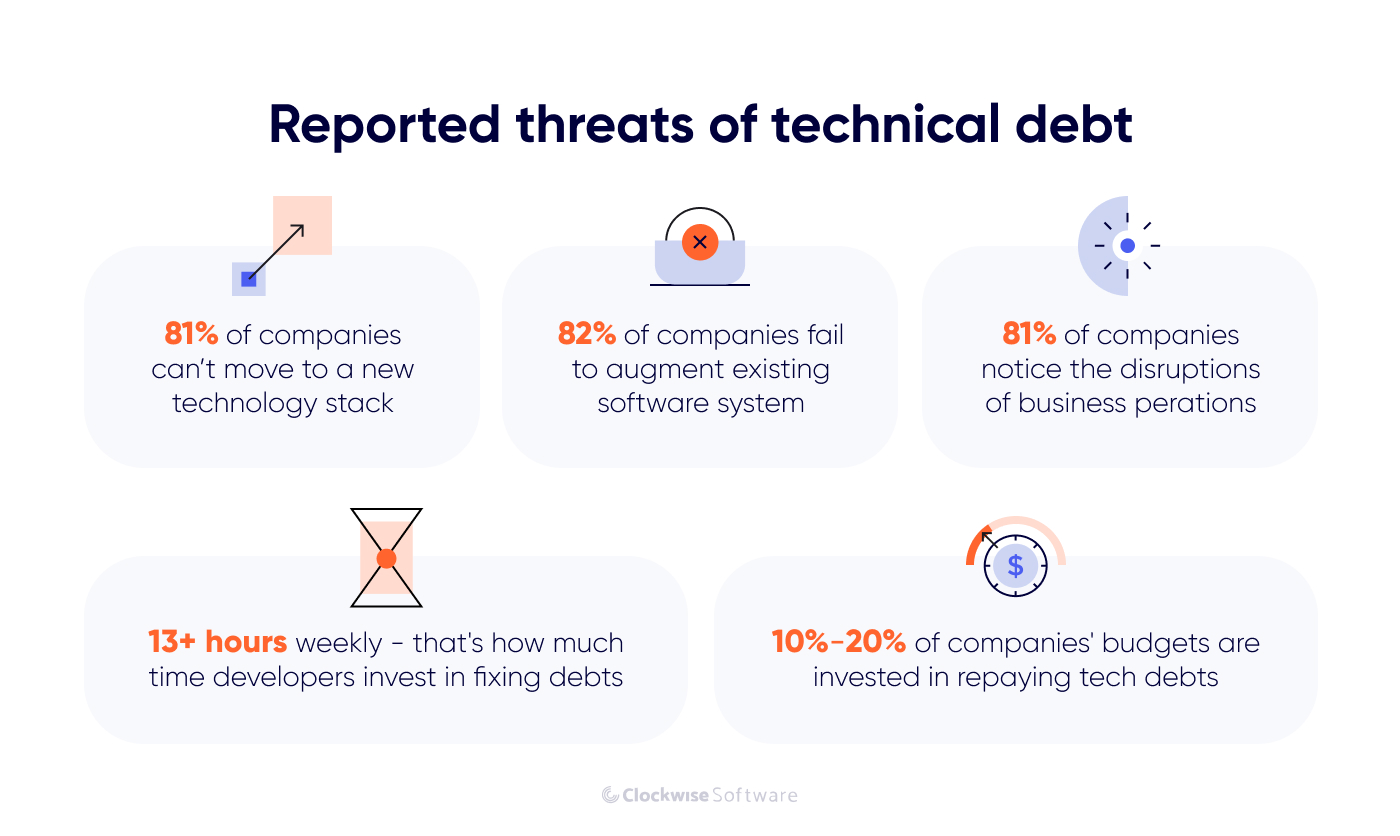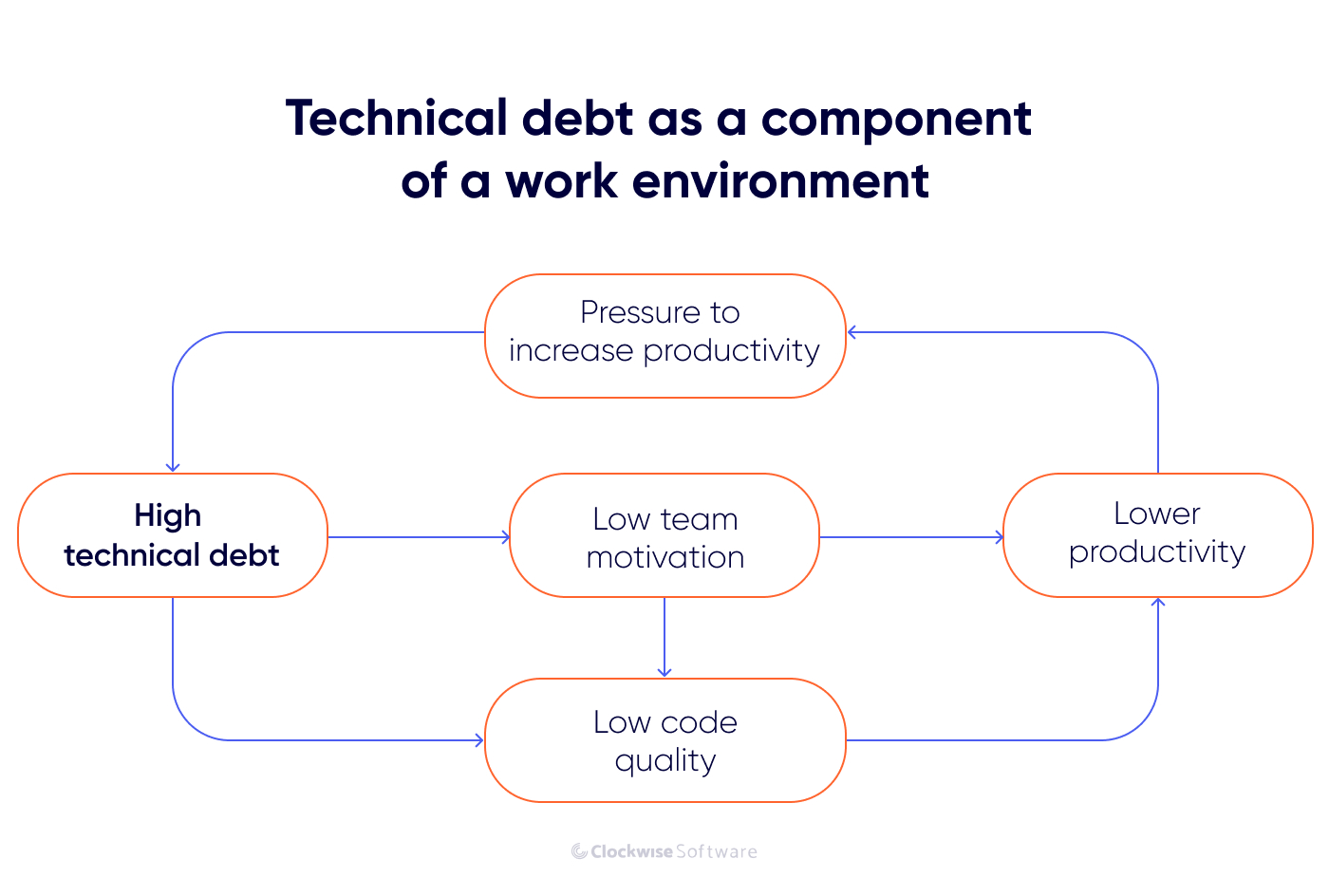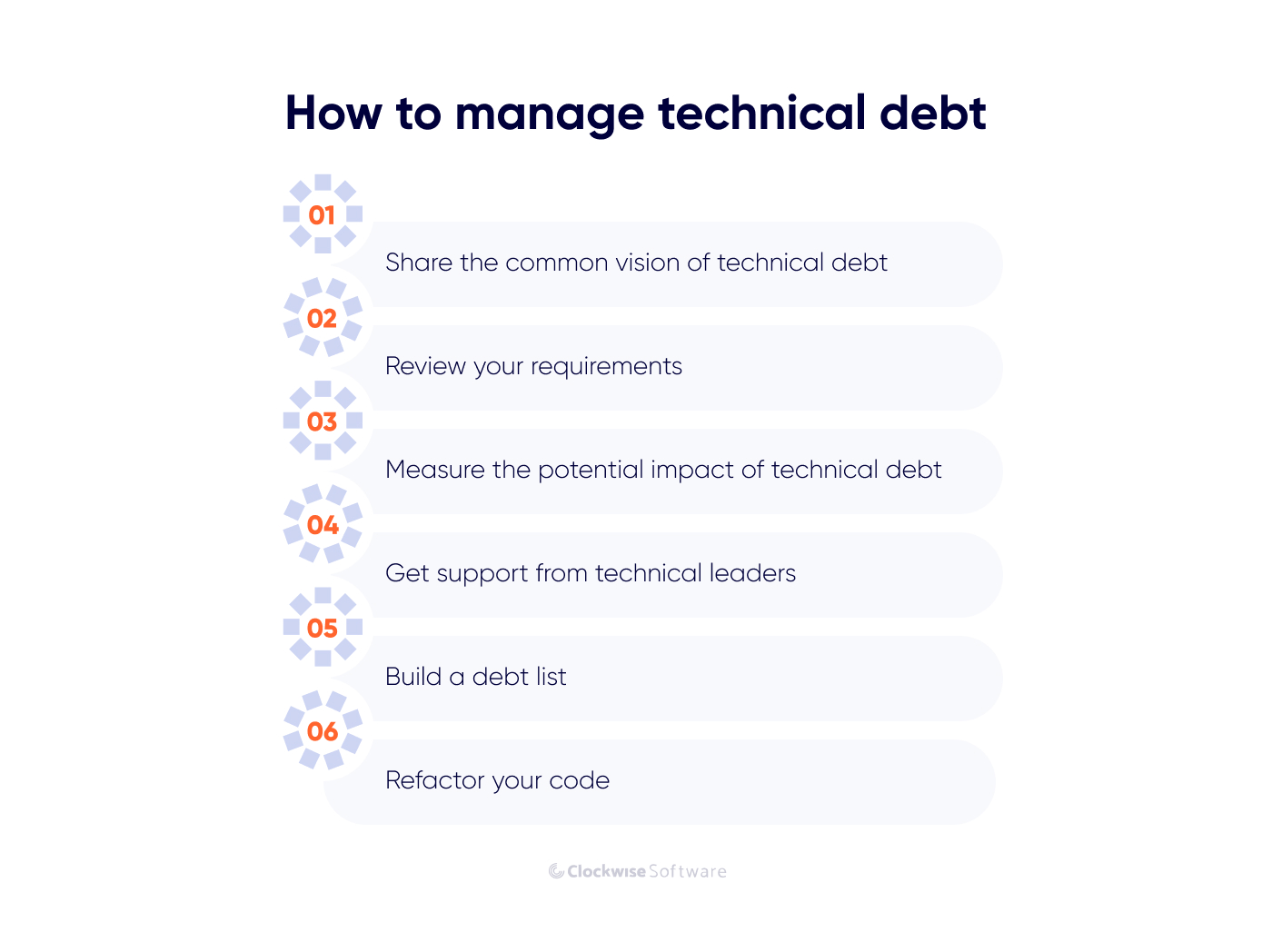What we do
Services
Experts in
More than 20 years ago, Ward Cunningham, one of the authors of the Agile Manifesto, aimed to justify the necessity of code refactoring to his management. Even today, justifying it may be a challenge: tasks related to code refactoring may not seem essential at first sight, and product owners, founders, and investors may be reluctant to invest in them.
But back in the 1990s, Cunningham took brilliant steps to prove this part of work is essential: he used an analogy with a financial system, calling problems with unoptimized code technical debt.
Ever since, hundreds of discussions have been growing around the concept of technical debt.
Technical debt is biting the resources of different companies – from tiny startups that have just started to collect their tech debt to huge enterprises with tech debts that may take an eternity to pay off.
But what is technical debt, and how to deal with it?
In this article, we’ll guide you through this concept and its features, highlight the potential threat of technical debt for your product, team, and entire business, and explain why it appears and how to cope with it.
The essence of technical debt hides in the simple tradeoff between a software product's short-term gains and long-term goals.
As you and your engineering team focus on short-term gains (for example, launching a product faster than your competitor may be a short-term gain), you may neglect actions or ignore risks related to rapid development (we can list poor code quality and errors here.)
The code quality may drop as you rush into product launch and prioritize speedy development over everything else. In contrast, the number of product bugs may multiply and cause your app to collapse – the moment may come when you can no longer add new functionality to your product, support it, and offer it to users because it either doesn’t work at all or works so poorly users abandon it.
Technical debt is a cost of technical decisions you make when prioritizing velocity over quality and elegance of a suggested solution.
You can apply this term to technologies, code and your entire Agile app development process.
Speedy development isn’t the only thing that puts you in front of debt-related challenges. In the next section, we’ll introduce to you five main reasons why technical debt occurs.
Technical debt happens to most projects you use daily: the smallest Silicon Valley startups and titans like Meta generate, manage, and pay off their technical debts. And technical debts start to increase for different companies for various reasons.
If you’ve read the previous section and are a lifestyle startup founder, this reason may have already come to your mind.
Technical debt mostly comes from two kinds of things. One is the time pressure.
As founders constantly strive to produce new apps faster than anyone else who comes with a similar idea, they may neglect the importance of quality of produced solutions. Software engineers may need a substantial amount to create an elegant, scalable, and maintainable solution. Without enough time, the intentional or unintentional mess may start, resulting in a massive tech debt later.
Failing to prepare, you prepare to fail.
Failing to define project requirements during the discovery phase and build a clear roadmap for startup, you make technical debt unavoidable.
According to our colleague – an experienced technical leader with over ten years of software engineering experience – this reason is one of the most essential, common, and impactful ones.
Say, a product owner decided to re-consider key requirements in the middle of a development sprint. It may impact developers’ focus and agenda; it may impact the scope of work for the remainder of the sprint; what’s most important – it impacts developers’ decisions, which may result in an increasing tech debt in the future.
Besides, if requirements change frequently, you can’t accurately calculate custom software development cost.
Tech debt may turn into loose sands for teams that have no technical leaders or for teams where technical leaders are too busy with urgent tasks.
Experienced technical leaders have proficiency in the tech debt sphere. They not only know how to detect when debt turns into a severe issue but also what steps to take to reduce debt and its impact on your business.
While you, as a business founder, focus on product growth and promotion, technical leaders concentrate on its quality, scalability, and maintainability – three things that technical debt may ruin. You can make technical debt harmless with a reliable in-house technical co-founder in your team or an external CTO.
Software development is a well-organized and synchronized process that involves multiple actions, operations, and decisions. You can imagine a software engineering team as a substantial multicomponent system where software engineers and technologies mutually interact.
Sometimes, a development process may seem a bit chaotic to you, and the only way to make it fruitful is to define and stick to development standards.
The software development standards may include a variety of guidelines, best practices, protocols, and other documentation that outlines the fundamental rules of the development process in your organization.
You may already know about common ISO standards for software engineering. Additionally, you and your team of engineering leaders may create your custom approach to standardization. But without any standards, you and your team risk failing to optimize your development process and, as a result, increase your technical debt.
Imagine you’re building your dream house. During construction, workers fail to design the roof properly. They know about it, yet they ignore the potential problem: they hope to fix it when the right time comes.
Of course, the right time never comes, and on the very first rainy night at your new home, you notice hideous leaks all over the freshly painted beige wall in your bedroom. You may even ignore it, too: maybe there are not many rainy days in your region. But one storm after another brings you a myriad of troubles, and leaks are only the minor ones. You simply ruin your house with your own hands by ignoring the problem.
The same may happen to your software.
You simply ruin your product by ignoring the necessity of software testing, bug fixing, and code refactoring.
It all starts with poor testing: you may invest less time and energy in software testing and miss critical errors due to a lack of resources. In the future, missed errors may become giant problems, ruin user experience, make your code unsupportable, increase expenses, and repel potential investors.
The list of decisions that cause the technical debt in your organization may go on, but there’s one crucial thing we’d like to point out.
Technical debt is unavoidable.
We can name numerous reasons that can increase technical debt and consider ways to minimize their impact; however, sooner or later, every project development team faces tech debt. Tech debts may vary in size, impact, and potential thread; however, the concept itself is not necessarily bad.
It’s the consequences of an increasing technical debt that can harm your company, not the tech debt itself.
What consequences may you face? Here are some of the reported challenges companies have to deal with because of increasing technical debt:

Technical debt is a part of a complex structure within your organization. It is interconnected with multiple components significant for both your software and your business development:

Your engineering team’s morale is going to go down the drain because no one likes to spend ages wrestling with technical debt that they know they should have dealt with if only the business had let them do it.
As you can see, technical debt isn’t just a technical thing; it’s a phenomenon related to all components and aspects of your business.
In the following sections, you’ll find out more about types of tech debt and ways to manage it.
To take a closer look at the question is technical debt bad? let’s talk about its types.
If a team's technical leadership decides to focus on short-term goals and prioritize a quick outcome while postponing optimization tasks for the future, we speak about intentional debt.
According to Team Asana, intentional debts may be divided into short-term and long-term categories depending on how long it may take to pay off the best. Short-term debts may be focused when a development team takes defined steps to achieve the desired goals and unfocused when a development team implements numerous shortcuts within various parts of functionality.
Unintentional debts may occur when a development team lacks an understanding of what functionality to implement and how to implement it. For instance, if a development team chooses the wrong architecture approach for a SaaS app due to false assumptions or unclear information from a product owner, this may be classified as an unintentional mistake – an unintentional tech debt.
Our team follows two primary approaches to avoid similar mistakes:
We can associate this type of tech debt with large enterprise projects.
Imagine that a big application grows with new functionality, modules, plugins, and lines of code. Presumably, dozens of developers may contribute to it. Specialists implement different coding methods, follow different best practices, and solve similar problems differently, or simply repeat themselves.
And the bigger the software system, the bigger the tech debt. Eventually, a bit rot tech debt may turn your software into an unsupportable monster, too complex and overengineered to keep it alive.
Dag Liodden, a co-founder and CTO of AdTech company Tapad, says that bit rot tech debt is the only type of tech debt that you should try to avoid consistently by continuous refactoring.
As long as it’s not excessive, and you’ve got a plan to properly manage it, there’s nothing wrong or abnormal with tech debt.
In this section, you can review several practices we recommend you implement to manage technical debts:

According to an article by Antonio Martini, Terese Besker, and Jan Bosch, 12% of respondents are unfamiliar with the concept of tech debt, while 6% are only slightly familiar with it. It allows us to assume that in a random organization, there’s a possibility that 1-2 team members know nothing about technical debt and how to cope with it.
What about your team?
One of the first steps we recommend taking is to share a common vision on technical debt among your teammates. What constitutes the concept of tech debt? How do you plan to pay it off in the future? Does your strategic planning include the resources to manage the future technical debt? Agree on the list of factors that describe the concept, and discuss metrics that will prove that your technical debt turns into issues.

Insights from our team: low-quality code doesn’t equal tech debt. The bad code becomes debt when it starts harming team velocity, business, and morale. Until then, a bad code is just a bad code. Thus, when managing tech debt, it is significant to ensure that you and your team understand the concept of tech debt the same way.
“Do we really need to do that?”
A simple question that may help you manage your tech debt from the very beginning. Initially, you, as a product owner, may either want to develop an MVP with numerous features or focus on primary functionality only to validate your idea. Both approaches may impact your technical debt. However, as you define app requirements and expectations clearly and review them frequently, you automatically take action to manage debts.
Insights from our team: consider practicing requirements elicitation sessions biweekly to make sure the whole team is on the same page and no obstacles may appear on your development journey for the next two weeks.
One of the ways to keep to a reasonable amount of tech debt is to keep an eye on significant project metrics constantly. There are numerous handy tools you can use to measure and analyze these metrics and manage your debt based on them:
Insights from our team: estimating tech debt and its impact on a legacy system may be challenging. The longer your project is in production, the longer you ignore the debt-related tasks – the bigger it grows and the more serious troubles it may cause.
Thus, our development team points out the importance of two factors:
Besides, quantitative data is not enough. Sometimes, you just need a technical eye to look upon your code and detect spots where technical debts grow.
Suppose your technical leaders and senior engineers are too busy with never-ending ongoing tasks, but your team starts noticing the impact of increasing debts on the entire software system. In that case, it may be the right time to:
Team extension may require time, attention, and a bunch of work related to the effective onboarding of new teammates.
Choosing the second option – CTO as a Service – you can get instant help, insights, advice, and a to-do list on how to manage technical debt from an external consultant in a matter of days.
Insights from our team: in the IT market, numerous companies provide CTO as a Service. We suggest you pay particular attention to the ones who offer not only consultations with experienced engineering specialist, but also suggests an opportunity to augment your team with external developers. In this case, by contacting a CTO as a Service specialist, you will also keep a chance to hire new specialists to help you resolve detected issues.
To control your technical debt, we recommend you know it.
You can manage it effectively with careful planning and a clear backlog of what and why needs to be done to pay off the debt. Consider creating a simple sheet and add the following rows to it:
Keeping track of your technical debts this way will help you not to miss essential debt details, save your development team’s time, and allocate your debt-related effort more effectively.
Insights from our team: categorize your debts. Discuss the list of debts with your technical leaders and define the ones you should pay off as soon as possible (urgently), in the near future (during the next 2-4 sprints), or later, when you’ll have resources to get it done.
Code refactoring is one of the most effective ways to:
By improving your codebase day by day, your development team increases the awareness of potential pitfalls and reinforces three cornerstones of your product: its quality, scalability, and maintainability.
Insights from our team: involve all your engineers in a refactoring process. Organize your development workflow in a way that allows all developers to devote their time and attention to both refactoring tasks and new functionality development.
Now you know several significant facts about technical debt:
With a clear plan for managing technical debt and support from a technical expert, you can avoid the potential threat of these consequences, optimize your development workflow, reduce software development cost, improve team performance, and achieve your business goals.
